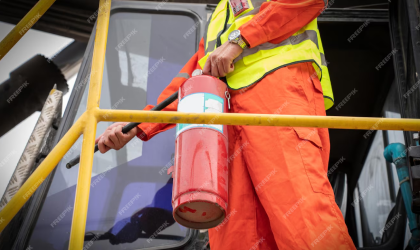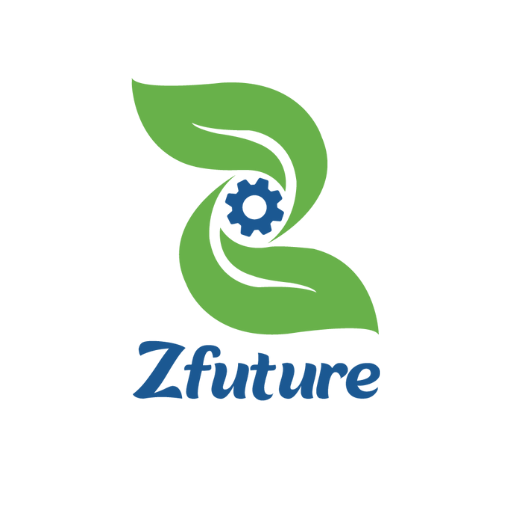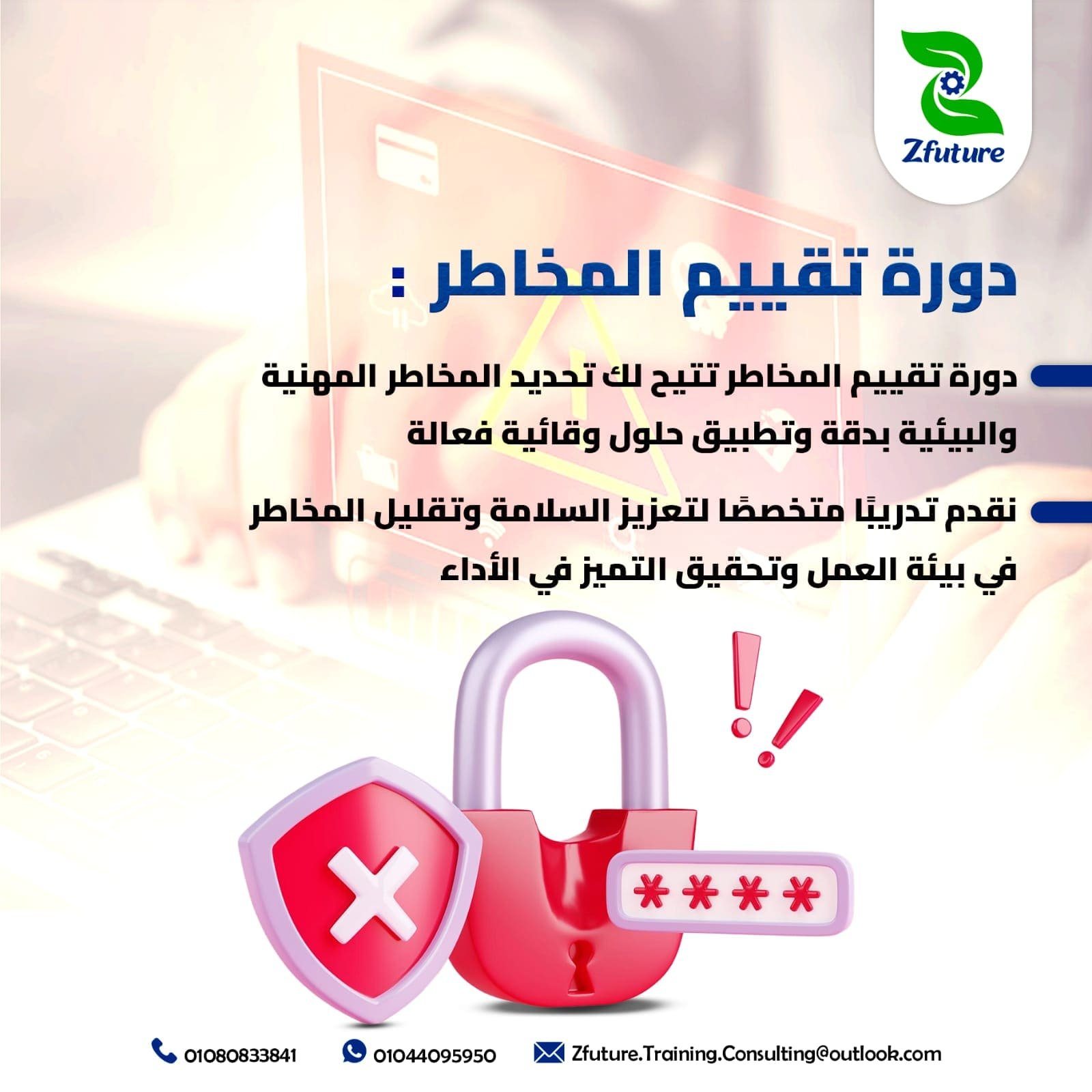Certified Risk Assessment Course in Egypt
A Risk Assessment course is a crucial step to ensure a safe and effective work environment. The course in risk management helps companies and organizations identify potential risks, analyze them, and take appropriate preventive measures. Risk analysis in the workplace is a vital process aimed at reducing accidents and enhancing productivity by managing risks efficiently.
In today’s business world, possessing the knowledge and skills necessary for risk management is a competitive advantage. Therefore, Zfuture offers specialized training courses in risk assessment and management, helping professionals gain the necessary experience and clear understanding of modern risk analysis techniques and decision-making strategies to protect individuals and assets.
Contact us now for free to get all the details about the training courses available from Zfuture Consulting and Training Company.
In this article, we will explore the concept of risk analysis, the Risk Assessment Course, and the essential steps for risk assessment, along with the importance of obtaining accredited certifications like PMI RMP to enhance one’s professional career in this field.

What is Risk Analysis in the Workplace?
Risk analysis in the workplace is a process aimed at identifying potential risks that could affect the safety of employees or the efficiency of operational processes within an organization. This analysis involves assessing factors that may lead to accidents, whether these are physical or chemical risks, as well as operational risks. Once these risks are identified, appropriate measures are taken to minimize or control them.
Risk analysis is an essential part of any risk assessment course, as it helps companies improve safety strategies and reduce losses caused by accidents or operational errors. By applying risk analysis methods, organizations can identify weaknesses in the work environment and address them before they turn into real problems.
Many companies and global organizations use workplace risk analysis as a preventive measure within occupational safety management systems, contributing to a safer work environment and increased productivity. Risk analysis can be performed using various methodologies, such as qualitative and quantitative risk analysis, depending on the nature of the work and safety requirements.
What is a Risk Assessment Course?
A Risk Assessment Diploma is a training program designed to equip individuals and professionals with the knowledge of how to identify potential risks in the workplace, analyze them, and take appropriate actions to minimize them. This course helps participants develop their skills in applying risk analysis strategies in the workplace, enabling them to enhance their ability to create a safe and sustainable environment.
The Risk Assessment course includes several key modules, including:
- Risk Management Concepts and Their Importance in Different Sectors.
- Modern Methods of Risk Assessment, such as qualitative and quantitative analysis.
- How to Apply Risk Reduction Measures in accordance with international standards.
- Steps in Risk Analysis and identifying potential threats.
The Risk Assessment course targets a wide range of professionals, including safety and health officers, as well as administrators, engineers, and anyone interested in enhancing their risk analysis skills in the workplace. By completing a Project Risk Management Course, trainees can easily improve their competence in addressing challenges faced in various work environments, contributing to enhanced productivity and reduced workplace accidents.
What is a Risk Management Certification?
A Risk Management Certification is a professional credential that proves an individual’s ability to identify, analyze, and manage risks in the workplace. This helps reduce potential threats and improves decision-making processes within organizations. These certifications are based on international standards and prepare holders to apply risk analysis methodologies in the workplace professionally.

The Importance of Risk Management Certification After Completing a Risk Assessment Course
- Enhancing Professional Skills in Risk and Crisis Management: Completing a risk assessment course and obtaining a risk management certification significantly strengthens a professional’s skills, allowing them to better handle risks and crises in various work environments.
- Qualification for Advanced Certifications Like PMI RMP: A risk management course prepares individuals to pursue advanced certifications, such as the PMI RMP (Professional Risk Management Certification), which further boosts their professional qualifications.
- Improved Ability to Effectively Apply Risk Analysis Strategies in the Workplace: With the knowledge gained through risk assessment training, individuals become more proficient in applying risk management techniques to create safer and more efficient work environments.
- Increased Employment Opportunities in Fields Like Project Management, Occupational Health and Safety, and Corporate Governance: Professionals with a risk management certification are in high demand across various industries, especially in project management, occupational health and safety, and governance roles, where risk management is crucial.
Famous Risk Management Certifications
- PMI RMP – Professional Risk Management Certification by PMI (Project Management Institute): This is one of the most prestigious global certifications in risk management. It is awarded by the Project Management Institute (PMI) and is designed for professionals who wish to validate their expertise in assessing and managing risks, and minimizing their impact on projects and operational processes.
- CRMP – Certified Risk Management Professional: This certification recognizes professionals who have the ability to identify, assess, and mitigate risks in an organization.
- ISO 31000 Risk Manager (ISO Risk Management Standards Certification): This certification aligns with the ISO 31000 standard for risk management and validates the ability to apply risk management processes in organizations.
These certifications help build a strong foundation in understanding organizational risks and developing plans to address them, making them an essential investment for professionals seeking to advance their careers in risk management.
What is PMI RMP Certification?
The PMI RMP (Professional Risk Management Certification) from the Project Management Institute (PMI) is one of the most prestigious global certifications in risk management and analysis. This certification is designed for professionals who want to demonstrate their expertise in assessing and managing risks, and their ability to minimize the impact of these risks on projects and operations.
Importance of PMI RMP Certification
- Proves the Ability to Make Risk-Based Decisions: The PMI RMP certification validates an individual’s ability to make informed decisions based on a comprehensive risk analysis.
- Prepares for Leadership Roles in Risk Management: The certification equips individuals to take on leadership positions in risk management within organizations, enabling them to oversee and guide risk mitigation strategies.
- Enhances Risk Analysis and Strategy Application in the Workplace: Certified professionals are adept at analyzing risks and applying effective strategies to mitigate them, which significantly improves organizational resilience.
- Increases Employment Opportunities in Key Sectors: PMI RMP certification opens doors to career opportunities in sectors such as engineering, project management, consulting, and finance.
Requirements to Obtain PMI RMP Certification
The eligibility criteria for applying for the PMI RMP exam depend on your educational background and work experience. Applicants must meet one of the following conditions:
- For individuals with a Bachelor’s degree or higher:
- 36 months of professional risk management experience.
- Completion of 30 hours of risk management training.
- For individuals with a high school diploma or associate degree:
- 60 months of professional risk management experience.
- Completion of 40 hours of risk management training.
How to Obtain PMI RMP Certification
To obtain the PMI RMP certification, follow these steps:
- Register for a Risk Management Course to acquire the fundamental knowledge required.
- Complete the Required Training Hours from an accredited institution like Zfuture.
- Take and Pass the PMI RMP Exam to validate your knowledge and expertise.
- Maintain the Certification by fulfilling the Continuing Professional Development (PDUs) requirements.
Why PMI RMP is a Successful Professional Investment
Obtaining the PMI RMP certification significantly enhances the ability to assess and manage risks in the workplace. It provides professionals with advanced strategies to solve problems and reduce operational threats, making them more competitive in the job market.

Types of Risks in the Workplace
Risk analysis in the workplace is essential to ensure the safety of employees and reduce occupational accidents. Risks can be classified into several main types based on their nature and impact on the work environment:
- Psychological and Social Risks:
- Work-related stress
- Inadequate working environments
- Long working hours
- Physical Risks:
- Noise
- Extreme temperatures (high or low)
- Radiation and vibrations
- Chemical Risks:
- Toxic gases
- Flammable materials
- Various chemical liquids
- Biological Risks:
- Viruses and bacteria
- Mold
- Contaminated medical waste
- Engineering and Operational Risks:
- Poorly designed machinery
- Structural collapses
- Use of unsafe equipment
- Electrical Risks:
- Exposed wires
- Working near high-voltage lines
- Failure to use protective tools
The Five Steps for Risk Assessment
To assess risks effectively, follow these five key steps to evaluate the magnitude of risks:
- Identify the Risks: Recognize all potential and expected risks in different work environments.
- Evaluate Who Is Affected and How: Determine which employees or individuals are exposed to risks and the potential impact on them.
- Assess the Risks and Take Preventive Measures: Analyze the level of danger and establish strategies to minimize or control the risks.
- Record Results and Implement Actions: Document the assessment and apply the necessary preventive measures.
- Review and Update the Assessment Regularly: Reevaluate risks periodically to ensure ongoing protection.
How to Achieve 5 Safety Risk Assessments in the Workplace
Achieving effective risk assessments in the workplace can be challenging. However, the following steps can increase your chances of success:
- Identify Potential Risks in the Work Environment.
- Evaluate the Individuals Exposed to Risks and How They Are Affected.
- Analyze Risks and Classify Them According to Severity and Likelihood.
- Implement Preventive and Protective Measures to Reduce Risks.
- Monitor and Update the Assessment Regularly to Ensure Effectiveness.
Why Choose a Risk Assessment Course from Zfuture?
Choosing a Risk Assessment Course from Zfuture guarantees several unique benefits that are hard to find elsewhere. Here are the reasons why many professionals opt for Zfuture:
- Comprehensive Curriculum:
- Covers all aspects of risk analysis in the workplace.
- Internationally Recognized Certifications:
- Prepares participants to obtain globally recognized certifications such as PMI RMP.
- Case Studies and Practical Exercises:
- Improves understanding of risks and effective risk management through practical examples.
- Interactive Learning:
- Includes workshops, tests, and direct consultations for a hands-on learning experience.
- Practical Training:
- Equips participants with the skills to apply the five steps for risk assessment effectively.
- Focus on Safety Standards:
- Emphasizes the latest safety and risk management standards to ensure compliance with laws and regulations.
- Certified Experts:
- The course is led by certified risk management and occupational safety experts.
Key Training Courses Offered by Zfuture:
- OSH Certification Course (with a certificate)
- Waste Management Course
- Environmental Training Courses
- Geographic Information Systems (GIS) Course
- Environmental Impact Assessment Course
- Occupational Safety and Health Course
- Sustainable Development Course
- Carbon Footprint Course
By enrolling in Zfuture’s risk assessment training courses, you will gain essential skills that will improve workplace safety, enhance productivity, and contribute to a safer working environment.

